
All children start to draw by creating doodles out of simple lines. In fact, drawing lines is an important art element we need to teach first. You can teach and support children in learning to draw by starting out with simple line exercises. In this blog, I want to focus on line drawing and share How To Teach Basic Line Drawing with simple step-by-step art projects. These projects can be really fun.,Plus set give them foundational concepts they need first! At the end of the blog I’ll list some teaching resources like free blogs, PDF downloads on line drawing, and drawing curriculum designed for children.
What are line elements?
Line elements are basic parts used to make drawings. In art class students learn about these parts and design rules. One of the first element to learn is line. Lines can look different, like straight, zigzag, or curved. There are many line types you can teach children to draw.
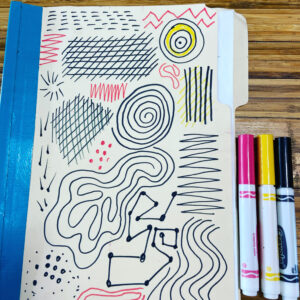
Why it’s important to teach line drawing?
Teaching children how to draw with lines is important because different lines build shapes, textures, and patterns. Lines help kids see how to break down pictures. When kids learn simple line, they can use lines to draw what they imagine or see. I’ve taught many kids how to draw and every lesson used lines! So teaching lines is foundational.

What line drawing lessons should you teach frist?
I like to start with curved and straight lines going in all kinds of directions, giving students plenty of practice. Once your students get the hang of making controlled lines, you can guide them to draw simple shapes. Teach them how to move from a line to a closed shape. Keep these first lessons simple. The goal is to help your students draw these line elements with good fine motor control. After they get the hang of it, encourage them to create simple drawings. If you would like to understand the best order to teach the elements and principles of design check out my early childhood or elementary art guide. I also have a drawing step-by-step curriculum you can order.
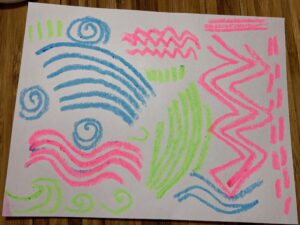
Basic line drawing skill sets
Reviewing line lessons can build hand and muscle memory, so review lessons often. Ask students to observe objects around them and see if they can identify an outline. Before they start drawing, challenge them to trace the outline with their finger in the air. This can help them notice the basic outline before putting pencil to paper. Encourage them to find lines or curves in the object. Training their artistic eye to look for basic lines and shapes will improve their drawing skills. Artists observe art elements within their artwork. Here are some line drawing skills to work on:
- Learn how to make sketch marks and erase effectively.
- Learn how to doodle using different mediums.
- Learn how to draw different types of lines accurately.
- Learn how to combine lines to create textures.
- Learn how to create patterns using lines.
- Learn how to color your line drawings using various mediums.
- Learn how to draw geometric shapes correctly.
- Learn how to draw simple organic shapes.
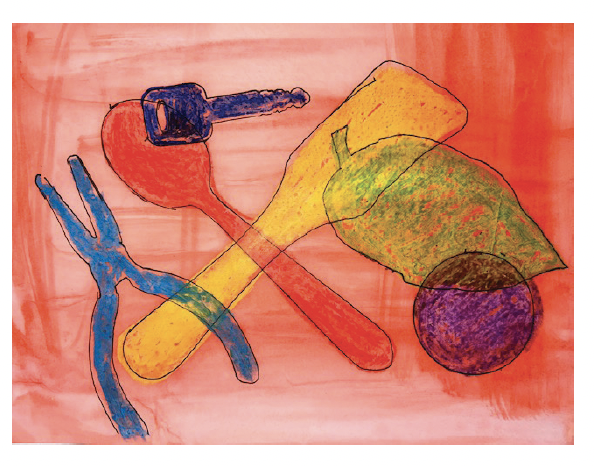
Drawing Lessons
Now I want to share some fun line drawing art lessons you can try after you’ve practiced basic line techniques. One of the lessons in my drawing curriculum is called “Drawing Conundrum,” where I have my students hunt around the classroom to outline shapes, and then overlap them. See the example above with objects like a key and spoon. These types of objects are easy to trace by outlining their shapes with lines. Then, move on to coloring them solid. You can find this lesson in my drawing curriculum HERE, along with other foundational line drawing lessons with step-by-step instructions.
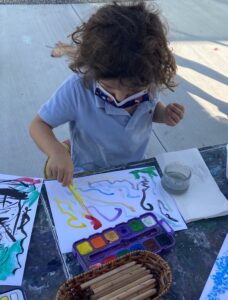
Painting lines
Another thing to know is that teaching line elements can cross over into other areas like painting, because the element of line can be found in all visual arts. For example, if you look at the picture of my young student working with paint, he is creating line brush marks. You can also create lines in crafts by adding texture and pattern with line designs. You can teach children how to paint by focusing on line brushstrokes. This is the method I use to teach children beginner painting lessons. You can check out my painting curriculum here.
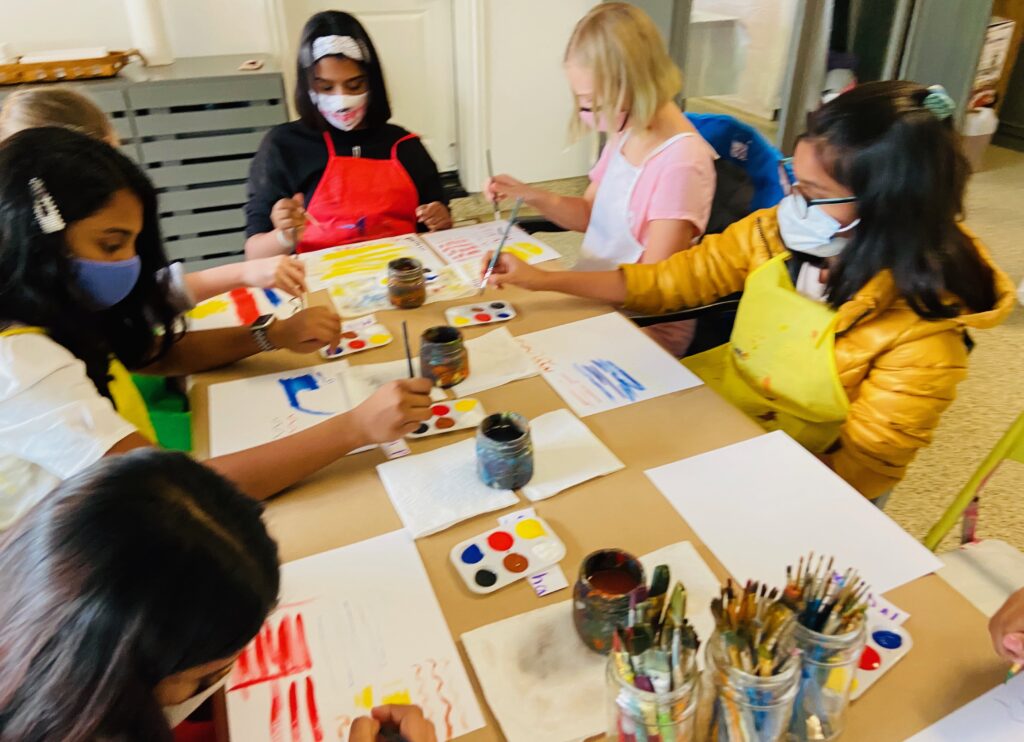
If you want to learn more about the Elements And Principles of Design, download my free PDF called Artsy Terms.
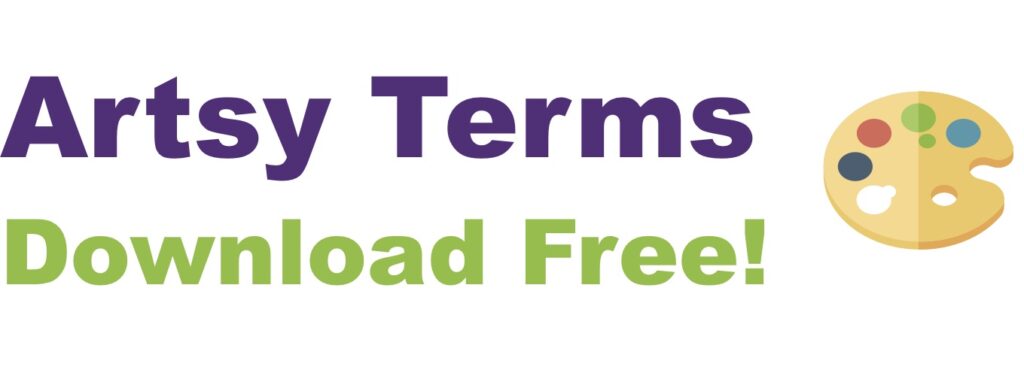

Line drawing best materials
- Sketch Pencils: These come in different hardness levels and are great for detailed lines and shading. They’re a must-have for any artist.
- Crayons: Easy to use, especially for kids, crayons make bold and bright lines. They’re good for adding texture and layering colors.
- Color Pencils: Offer many colors and can be blended or layered. Perfect for adding details and bright colors to drawings.
- Watercolor Pencils: Can be used dry for lines or with water for a soft, painted look. They add depth to drawings.
- Watercolor Crayons: Are great for drawing lines, and can them turn into paint.
- Oil Pastels: Creamy and easy to blend, these are great for making bold, colorful lines.
- Soft Pastels: They provide a matte look and vibrant colors, perfect for smooth lines and soft transitions.
- Tempera Drawing Sticks: Easy to hold, these sticks create bright, opaque lines. Good for bold and quick sketches.
- Markers: Known for their strong colors and smooth lines, markers are ideal for clear outlines and can be layered for effect.
Line Art Drawing Curriculum
I recommend that students from early childhood through elementary grades focus on the core art elements and a few principles initially. This usually includes the core seven: line, shape, color, form, value, texture, and space. Then, in middle and high school, students start learning the principles of design. Line drawing curriculum can be easy to follow and teach to children. Focus on learning how to create 2D images, which will build fine motor skills. Once you’ve taught children the basics, you can transition to teaching 3D drawing on a 2D plane. Students can then move on to learning how to create value and 3D perspective.
I hope this blog has helped you understand why it’s important to teach children line drawing lessons. I’d love to hear your feedback. Check out all my teaching resources and order my drawing curriculum to set you on the right path quickly.
All rights reserved © 2025, Nature of Art®

No part of this blog may be used or be reproduced in any manner whatsoever including reproducing, publishing, performing, and making any adaptions of the work – including translation into another foreign language without written permission except in the case of brief quotations embodied in critical articles and reviews. Nature of Art® Publishing P.O. Box 443 Solana Beach, California 92075.